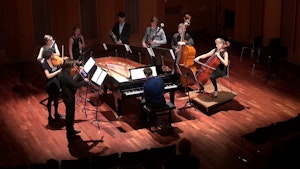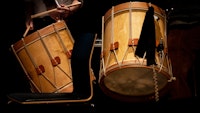In the project, Symphonies Reframed large orchestral works are re-arranged for a medium-sized chamber ensemble comprising 7–9 instrumentalists plus singers where required. Examples of such works are Brahms’ Symphony No. 4, Schumann’s Symphony No. 2, Mozart's Piano Concerto No. 20, Brahms’ A German Requiem and Mozart’s The Impresario. Since the ensemble is made up of equal numbers of strings and winds plus piano, the instrumental format is dubbed “triharmonic ensemble”. As well as reducing orchestral formats to medium-sized chamber scores, the project also includes expanding smaller-scale works. Brahms’ Sonata No. 1 for Clarinet and Piano has for example been enlarged to involve eight musicians rather than two.
Our chamber ensembles are made up of NMH students and teachers. All transcriptions are by Sigstein Folgerø.
More about the project
Read more about the project and view videos in Research Catalogue.


